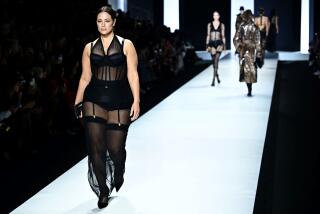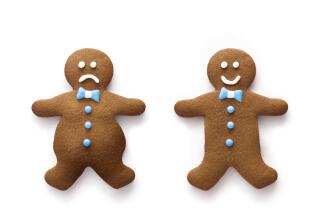Diet, Exercise Researchers Disagree if Plump Is Bad
- Share via
WASHINGTON — Media images to the contrary, a woman can be big, beautiful and healthy, declares 5-foot-11, 185-pound model Emme Aronson.
American women have been taught that they must look like waifs, and it’s wrong, she said.
“The first step in finding out who we are as women, because we have been predominantly neglected in the imagery of America, is to find out where we are at,” said Emme, who uses only her first name professionally. “I would advise women who are fuller figured to find out what their body type is.”
Some experts on exercise and diet agree. They think the gristle-and-muscle, washboard abs look is dangerous for many women.
“I’m not using the word ‘thin’ anymore, I’m using the word ‘scrawny,’ ” said Barbara L. Drinkwater of Pacific Medical Center in Seattle. “Scrawny doesn’t have quite the feel to it that thin does.”
Drinkwater is an expert on eating disorders and high-intensity athletics that can weaken the body of a teenage girl or a woman to the point at which she ceases to replace all the calcium in her bones. This can increase a woman’s risk of osteoporosis, the brittle bone disease, later in life.
In addition, the self-starvation eating disorder anorexia nervosa can lead to death, although many of those deaths are reported as resulting from heart attack or suicide instead of anorexia, Drinkwater said.
“I wish we could go back to Marilyn Monroe,” Drinkwater said. “There was a beautiful woman. But she did have curves, didn’t she?”
“I know I am going to have curves and hips,” said Emme, who models plus-size clothes, and who has done ads for such companies as Macy’s, Bloomingdale’s and Liz Claiborne.
Girls and women in such sports as gymnastics, however, are under pressure to keep their bodies straight and light. And the pressure goes beyond athletics, Drinkwater said: “These women come into a sport from a culture that says you can never be too thin.”
But they don’t have to be thin to be athletic, said Emme, 33, who was a rower at Syracuse University. Even now, she hikes, bikes and does isometric and water exercises, she said. “When I am firmer, I feel better,” the model said.
Nor are washboard abs within most people’s reach, Emme said. “Do you realize how much work you would have to do?” she said. “You would have to be in the gym all the time--and restricting your fat intake.”
This isn’t to say it’s safe to be obese, said Dr. Pauline S. Powers of the Eating Disorders Clinic at the University of South Florida in Tampa. Obesity, typically defined in women as 30% or more of body mass in fat, is associated with a higher risk of such conditions as heart attack and diabetes. Merely being overweight doesn’t carry this risk, she said.
The problem is that obesity is hard to treat, since 95% of diets eventually fail, Powers said. A better approach is to combine regular exercise and sensible eating, she said.
But even this goal is hard to reach because of women’s ideas about what their bodies look like, Powers said. Because they don’t want others to stare at them, many obese women won’t go to a health club, she said: “The very thing that might help them, they are afraid of.” They might join walking or swimming groups for other obese people, she said.
However, some prominent researchers stand by the health value of the thin look. Among them is I-Min Lee of Harvard Medical School. She noted Harvard research that concluded that even a little plumpness raises the risk of death, while the very thin live longer.
The problem is in fat, she said--it’s fine for a big woman to be muscular. As for any health value in looking like Marilyn Monroe? “I personally don’t think so,” she said.






